Exhibit 99.1
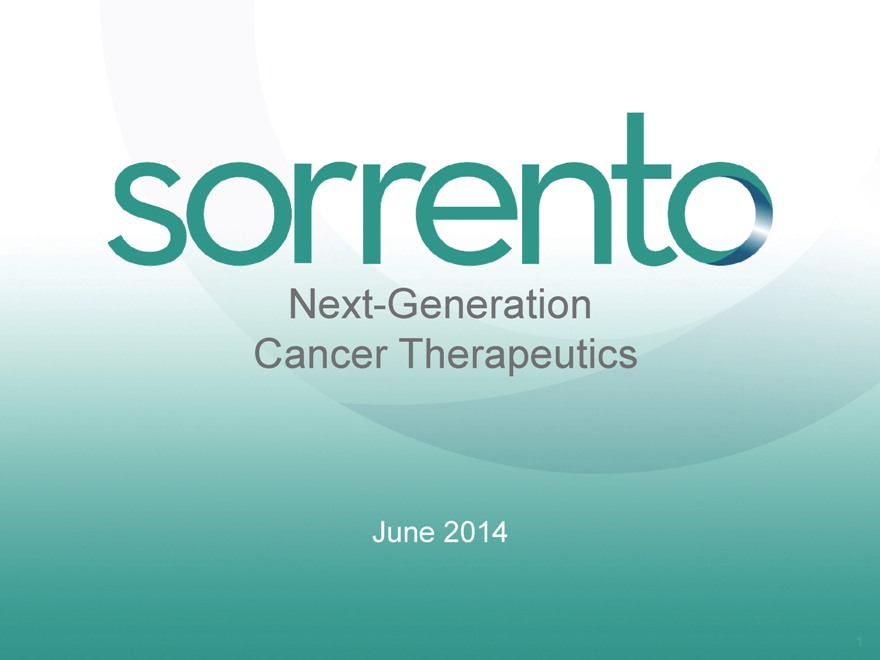
Exhibit 99.1
Next-Generation Cancer Therapeutics
June 2014
1
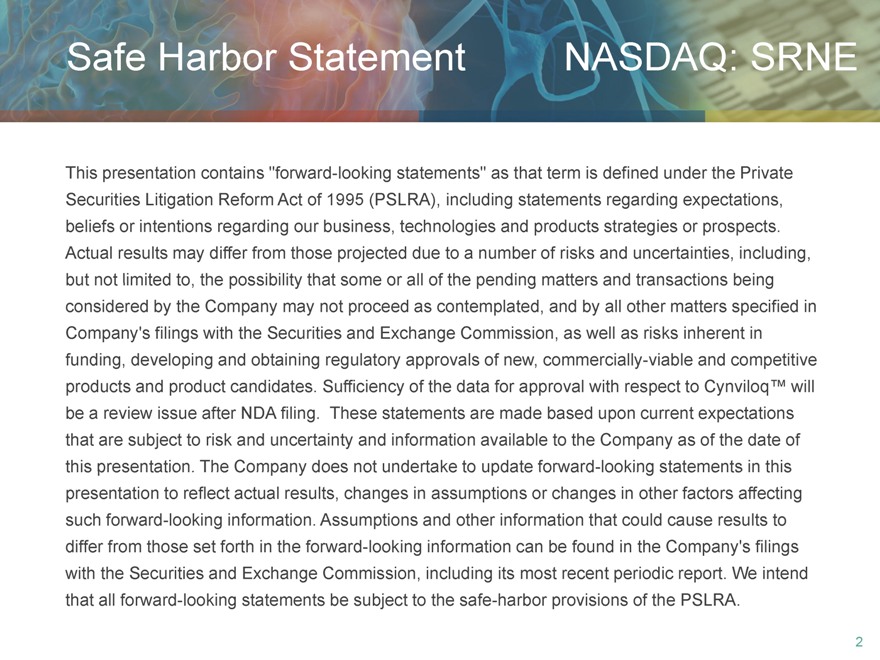
Safe Harbor Statement NASDAQ: SRNE
This presentation contains “forward-looking statements” as that term is defined under the Private Securities Litigation Reform Act of 1995 (PSLRA), including statements regarding expectations, beliefs or intentions regarding our business, technologies and products strategies or prospects. Actual results may differ from those projected due to a number of risks and uncertainties, including, but not limited to, the possibility that some or all of the pending matters and transactions being considered by the Company may not proceed as contemplated, and by all other matters specified in Company’s filings with the Securities and Exchange Commission, as well as risks inherent in funding, developing and obtaining regulatory approvals of new, commercially-viable and competitive products and product candidates. Sufficiency of the data for approval with respect to Cynviloq™ will be a review issue after NDA filing. These statements are made based upon current expectations that are subject to risk and uncertainty and information available to the Company as of the date of this presentation. The Company does not undertake to update forward-looking statements in this presentation to reflect actual results, changes in assumptions or changes in other factors affecting such forward-looking information. Assumptions and other information that could cause results to differ from those set forth in the forward-looking information can be found in the Company’s filings with the Securities and Exchange Commission, including its most recent periodic report. We intend that all forward-looking statements be subject to the safe-harbor provisions of the PSLRA.
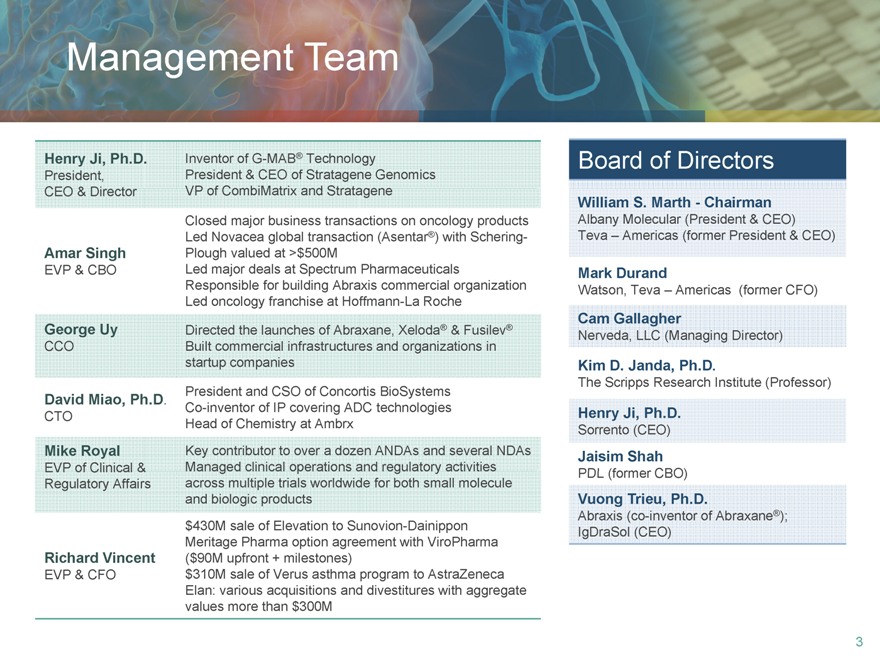
Management Team
Henry Ji, Ph.D. Inventor of G-MAB® Technology
President, President & CEO of Stratagene Genomics
CEO & Director VP of CombiMatrix and Stratagene
Closed major business transactions on oncology products
Led Novacea global transaction (Asentar®) with Schering-
Amar Singh Plough valued at >$500M
EVP & CBO Led major deals at Spectrum Pharmaceuticals
Responsible for building Abraxis commercial organization
Led oncology franchise at Hoffmann-La Roche
George Uy Directed the launches of Abraxane, Xeloda® & Fusilev®
CCO Built commercial infrastructures and organizations in
startup companies
David Miao, Ph.D. President and CSO of Concortis BioSystems
Co-inventor of IP covering ADC technologies
CTO Head of Chemistry at Ambrx
Mike Royal Key contributor to over a dozen ANDAs and several NDAs
EVP of Clinical & Managed clinical operations and regulatory activities
Regulatory Affairs across multiple trials worldwide for both small molecule
and biologic products
$430M sale of Elevation to Sunovion-Dainippon
Meritage Pharma option agreement with ViroPharma
Richard Vincent ($90M upfront + milestones)
EVP & CFO $310M sale of Verus asthma program to AstraZeneca
Elan: various acquisitions and divestitures with aggregate
values more than $300M
Board of Directors
William S. Marth—Chairman
Albany Molecular (President & CEO)
Teva – Americas (former President & CEO)
Mark Durand
Watson, Teva – Americas (former CFO)
Cam Gallagher
Nerveda, LLC (Managing Director)
Kim D. Janda, Ph.D.
The Scripps Research Institute (Professor)
Henry Ji, Ph.D.
Sorrento (CEO)
Jaisim Shah
PDL (former CBO)
Vuong Trieu, Ph.D.
Abraxis (co-inventor of Abraxane®);
IgDraSol (CEO)
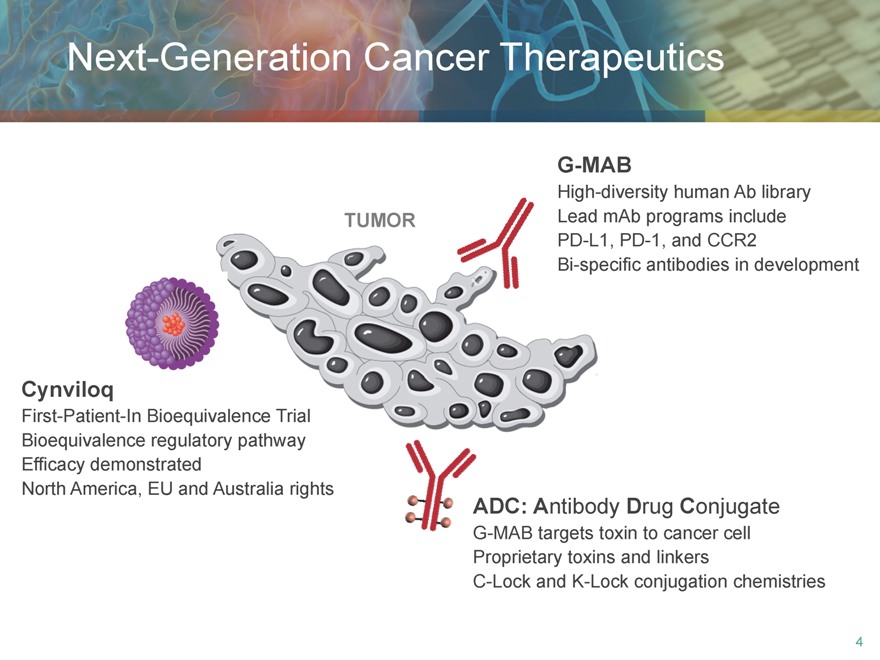
Next-Generation Cancer Therapeutics
G-MAB
High-diversity human Ab library TUMOR Lead mAb programs include PD-L1, PD-1, and CCR2 Bi-specific antibodies in development
Cynviloq
First-Patient-In Bioequivalence Trial Bioequivalence regulatory pathway Efficacy demonstrated North America, EU and Australia rights
ADC: Antibody Drug Conjugate
G-MAB targets toxin to cancer cell Proprietary toxins and linkers
C-Lock and K-Lock conjugation chemistries
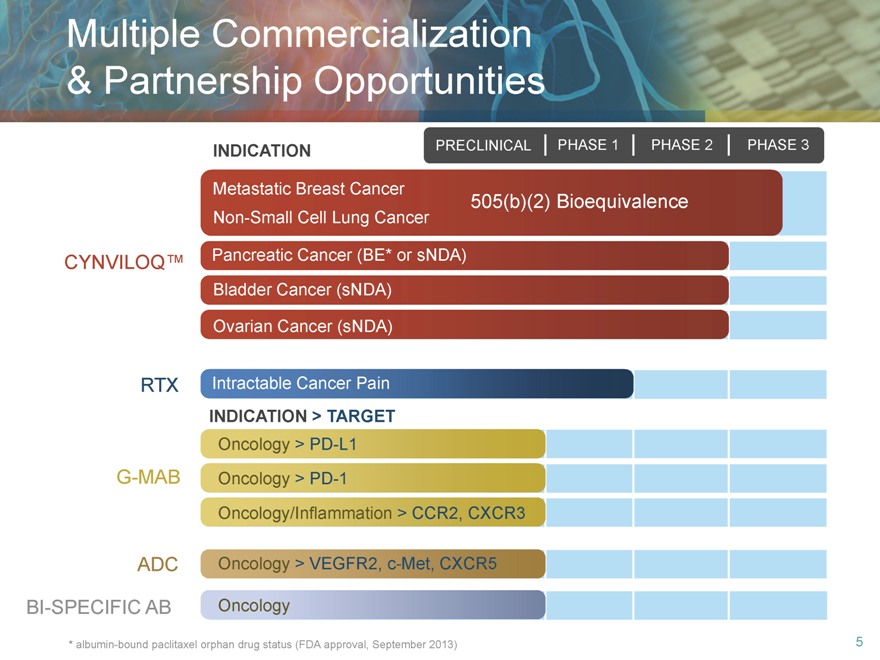
Multiple Commercialization
& Partnership Opportunities
INDICATION PRECLINICAL PHASE 1 PHASE 2 PHASE 3
Metastatic Breast Cancer
Non-Small Cell Lung Cancer 505(b)(2) Bioequivalence CYNVILOQ™ Pancreatic Cancer (BE* or sNDA) Bladder Cancer (sNDA)
Ovarian Cancer (sNDA)
RTX Intractable Cancer Pain
INDICATION > TARGET
Oncology > PD-L1 G-MAB Oncology > PD-1
Oncology > VEGFR2, c-Met, CXCR5
Oncology/Inflammation > CCR2, CXCR3
ADC
BI-SPECIFIC AB Oncology
* | | albumin-bound paclitaxel orphan drug status (FDA approval, September 2013) |
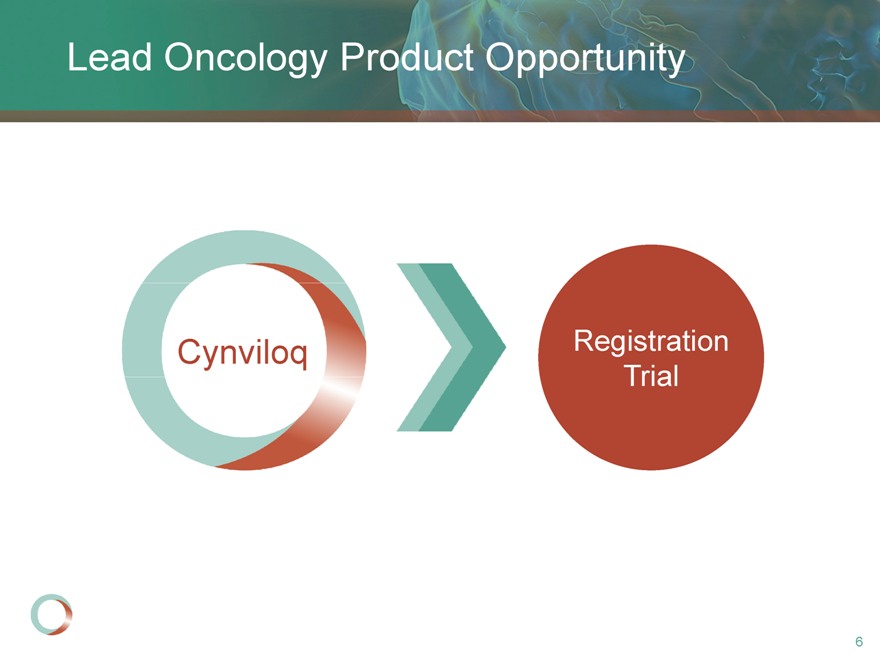
Lead Oncology Product Opportunity
Cynviloq
Registration Trial
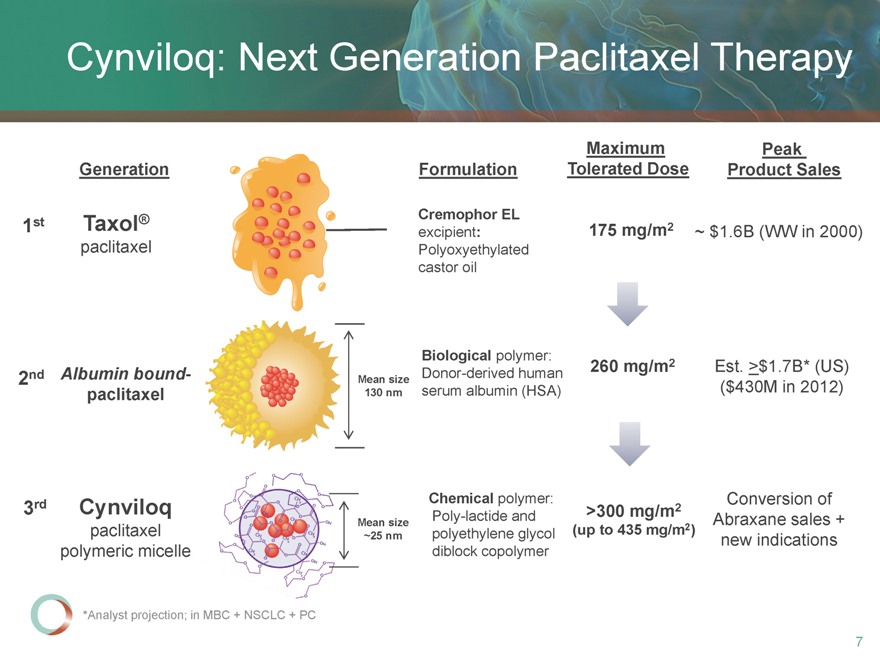
Cynviloq: : Next Generation Paclitaxel Therapy
Maximum Peak Generation Formulation Tolerated Dose Product Sales
® Cremophor EL
1st Taxol 175 mg/m2 paclitaxel excipient: ~ $1.6B (WW in 2000)
Polyoxyethylated castor oil
Biological polymer:
260 mg/m2 Est. >=$1.7B* (US)
2nd Albumin bound- Mean size Donor-derived human paclitaxel 130 nm serum albumin (HSA) ($430M in 2012)
rd Chemical polymer: Conversion of
Poly-lactide and Abraxane sales +
Mean size 2
paclitaxel ~25 nm polyethylene glycol (up to 435 mg/m ) new indications polymeric micelle diblock copolymer
*Analyst projection; in MBC + NSCLC + PC
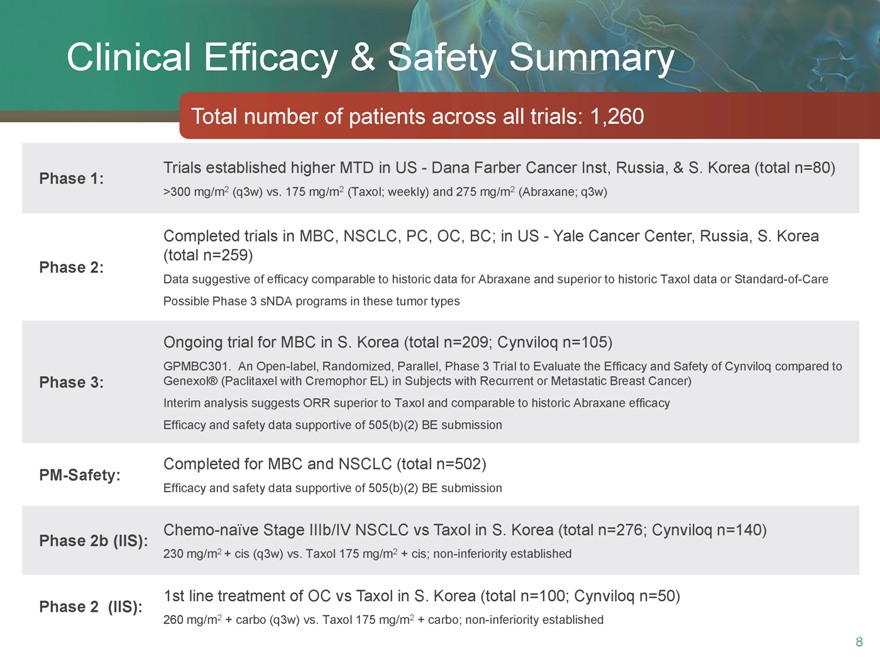
Clinical Efficacy & Safety Summary
Total number of patients across all trials: 1,260
Trials established higher MTD in US—Dana Farber Cancer Inst, Russia, & S. Korea (total n=80)
Phase 1:
>300 mg/m2 (q3w) vs. 175 mg/m2 (Taxol; weekly) and 275 mg/m2 (Abraxane; q3w)
Completed trials in MBC, NSCLC, PC, OC, BC; in US—Yale Cancer Center, Russia, S. Korea (total n=259)
Phase 2:
Data suggestive of efficacy comparable to historic data for Abraxane and superior to historic Taxol data or Standard-of-Care Possible Phase 3 sNDA programs in these tumor types
Ongoing trial for MBC in S. Korea (total n=209; Cynviloq n=105)
GPMBC301. An Open-label, Randomized, Parallel, Phase 3 Trial to Evaluate the Efficacy and Safety of Cynviloq compared to Phase 3: Genexol® (Paclitaxel with Cremophor EL) in Subjects with Recurrent or Metastatic Breast Cancer) Interim analysis suggests ORR superior to Taxol and comparable to historic Abraxane efficacy Efficacy and safety data supportive of 505(b)(2) BE submission
Completed for MBC and NSCLC (total n=502)
PM-Safety:
Efficacy and safety data supportive of 505(b)(2) BE submission
Chemo-naïve Stage IIIb/IV NSCLC vs Taxol in S. Korea (total n=276; Cynviloq n=140)
Phase 2b (IIS):
230 mg/m2 + cis (q3w) vs. Taxol 175 mg/m2 + cis; non-inferiority established
1st line treatment of OC vs Taxol in S. Korea (total n=100; Cynviloq n=50)
Phase 2 (IIS):
260 mg/m2 + carbo (q3w) vs. Taxol 175 mg/m2 + carbo; non-inferiority established
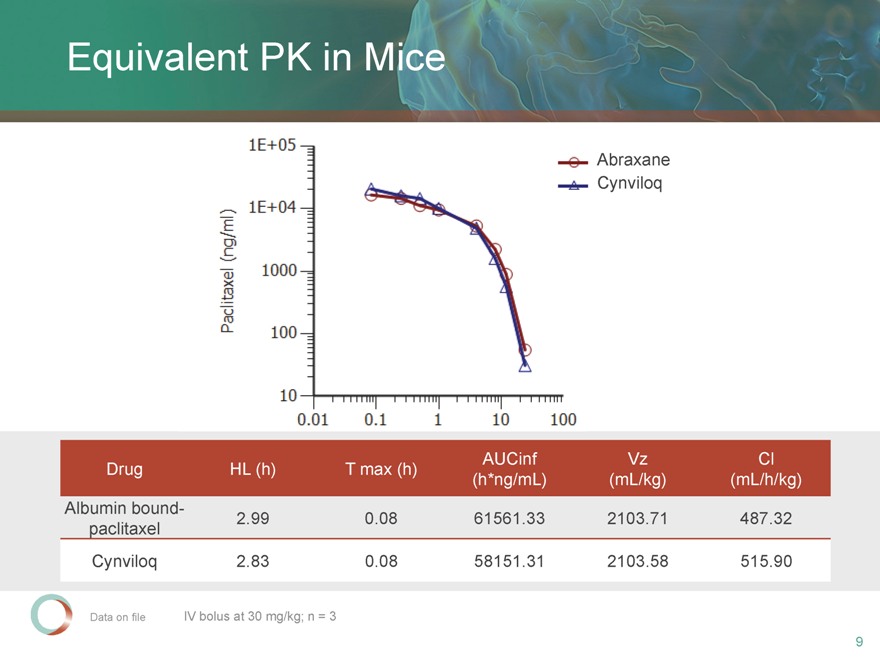
Equivalent PK in Mice
Abraxane Cynviloq
AUCinf Vz Cl Drug HL (h) T max (h) (h*ng/mL) (mL/kg) (mL/h/kg) Albumin bound-
2.99 0.08 61561.33 2103.71 487.32 paclitaxel Cynviloq 2.83 0.08 58151.31 2103.58 515.90
Data on file IV bolus at 30 mg/kg; n = 3
9
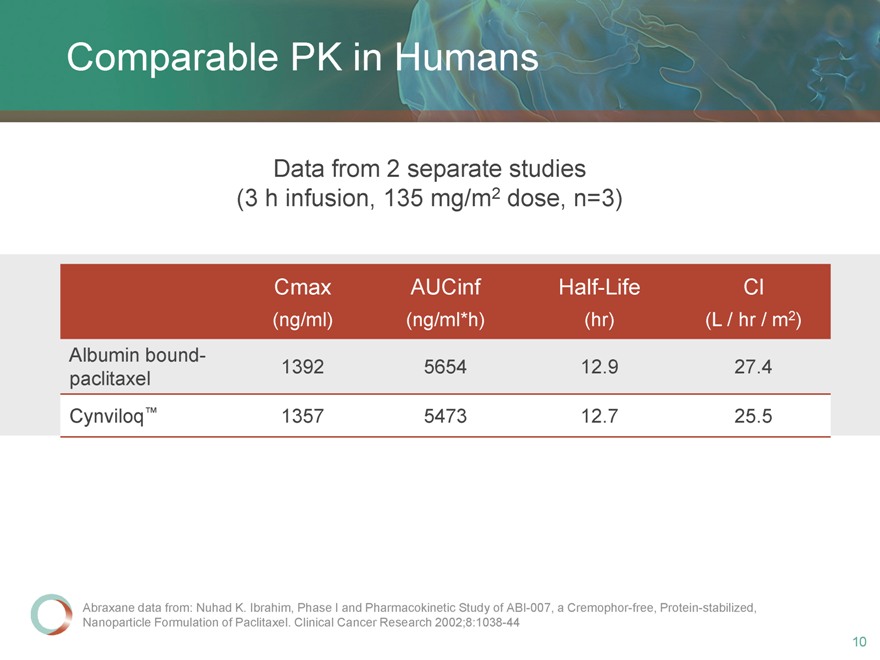
Comparable PK in Humans
Data from 2 separate studies (3 h infusion, 135 mg/m2 dose, n=3)
Cmax AUCinf Half-Life Cl
(ng/ml) (ng/ml*h) (hr) (L / hr / m2)
Albumin bound-
paclitaxel 1392 5654 12.9 27.4
Cynviloq™ 1357 5473 12.7 25.5
Abraxane data from: Nuhad K. Ibrahim, Phase I and Pharmacokinetic Study of ABI-007, a Cremophor-free, Protein-stabilized, Nanoparticle Formulation of Paclitaxel. Clinical Cancer Research 2002;8:1038-44
10
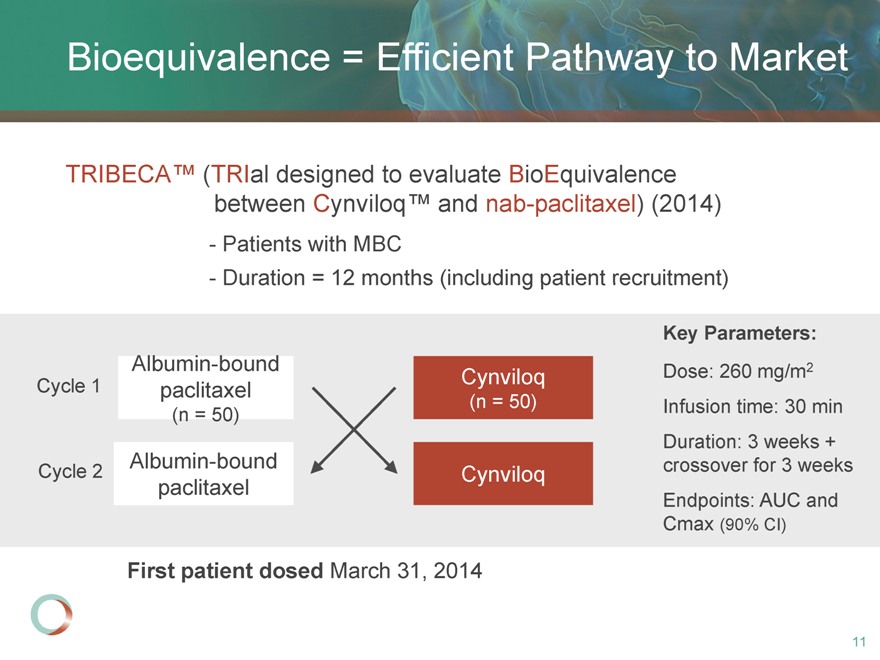
Bioequivalence = Efficient Pathway to Market
TRIBECA™ (TRIal designed to evaluate BioEquivalence between Cynviloq™ and nab-paclitaxel) (2014)
- Patients with MBC
- Duration = 12 months (including patient recruitment)
Key Parameters:
Albumin-bound Dose: 260 mg/m2 Cycle 1 Cynviloq paclitaxel
(n = 50) Infusion time: 30 min
(n = 50)
Albumin-bound Duration: 3 weeks + Cycle 2 Cynviloq crossover for 3 weeks paclitaxel
Endpoints: AUC and
Cmax (90% CI)
First patient dosed March 31, 2014
11
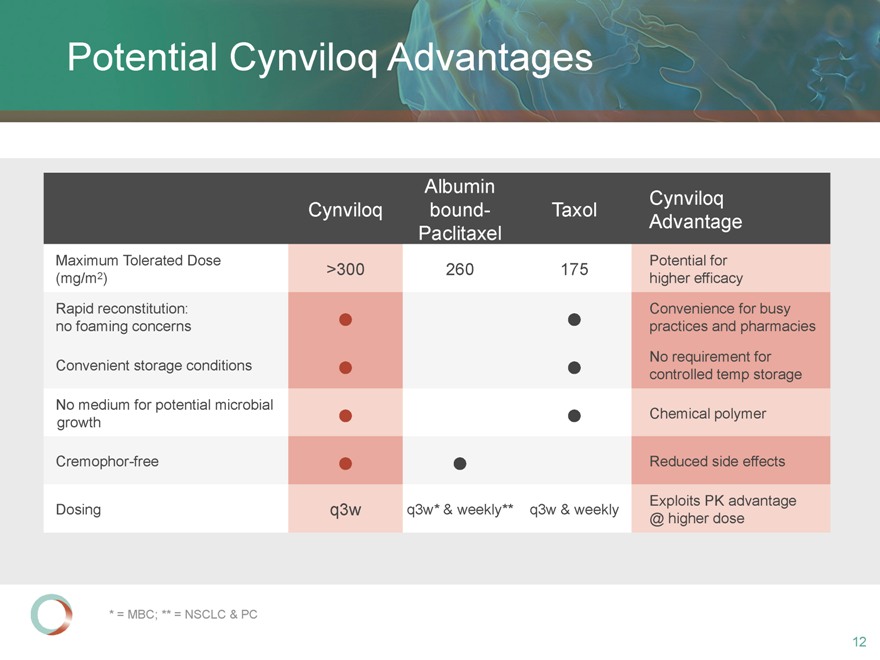
Potential Cynviloq Advantages
Albumin Cynviloq
Cynviloq bound- Taxol Advantage
Paclitaxel
Maximum Tolerated Dose Potential for
>300 260 175
(mg/m2) higher efficacy
Rapid reconstitution: • • Convenience for busy
no foaming concerns practices and pharmacies
Convenient storage conditions • • No requirement for
controlled temp storage
No medium for potential microbial growth • • Chemical polymer
Cremophor-free • • Reduced side effects
Dosing q3w q3w* & weekly** q3w & weekly Exploits PK advantage
@ higher dose
12
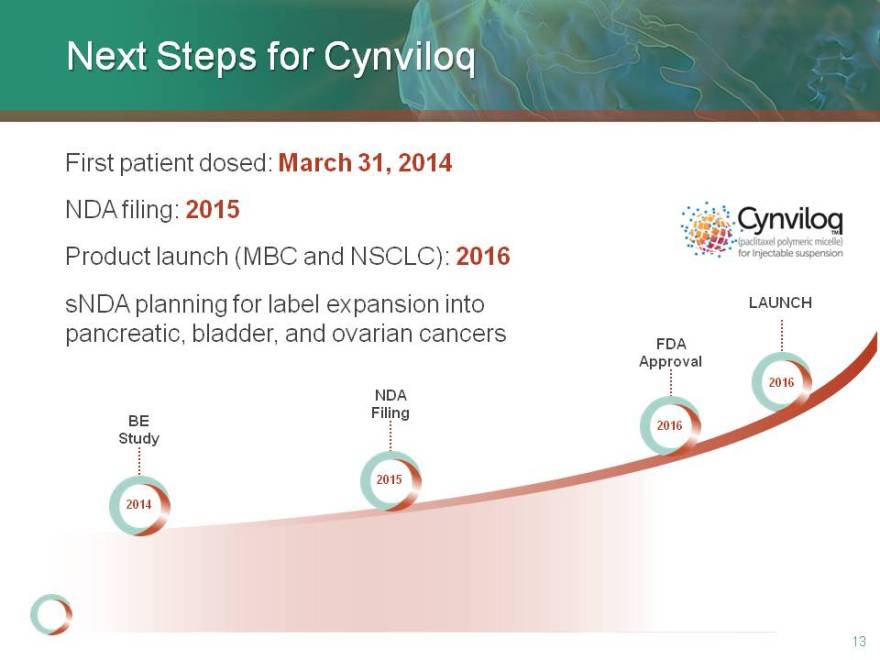
Next Steps for Cynviloq
First patient dosed: March 31, 2014 NDA filing: 2015 Product launch (MBC and NSCLC): 2016 sNDA planning for label expansion into LAUNCH pancreatic, bladder, and ovarian cancers
BE Study 2014
NDA Filing 2015
FDA Approval 2016
LAUNCH 2016
13
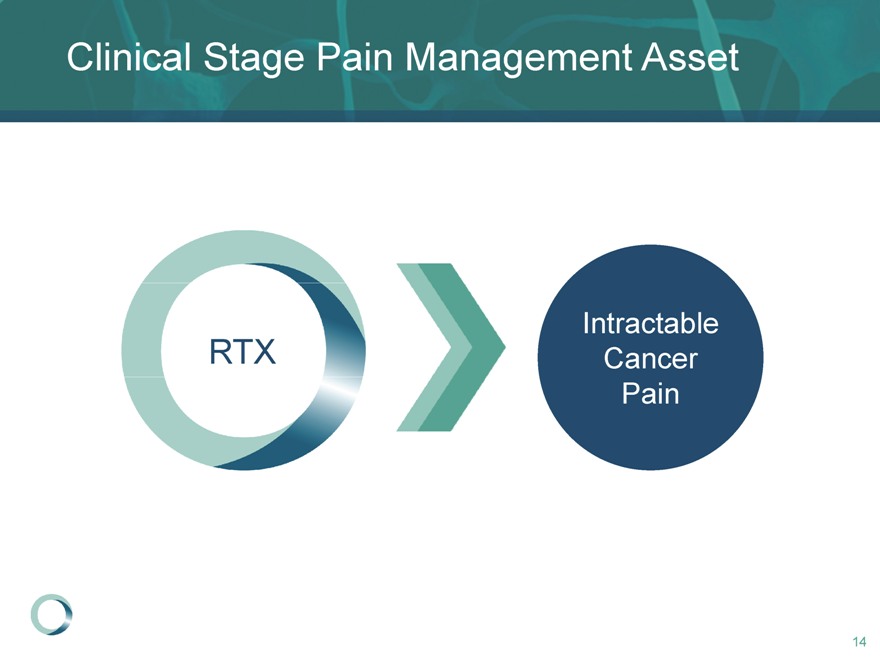
Clinical Stage Pain Management Asset
RTX
Intractable Cancer Pain
14
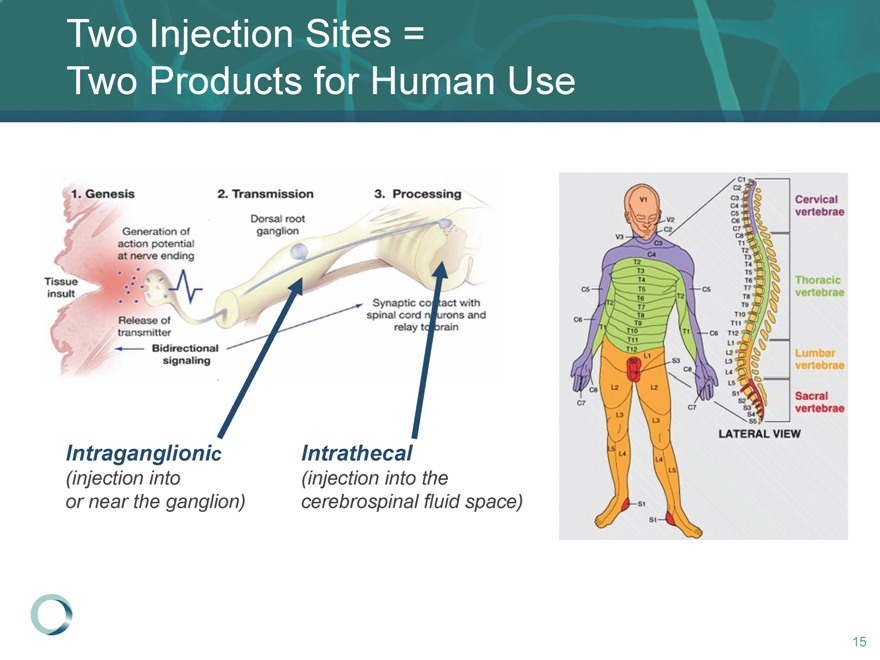
Two Injection Sites = Two Products for Human Use
Intraganglionic Intrathecal
(injection into (injection into the or near the ganglion) cerebrospinal fluid space)
15
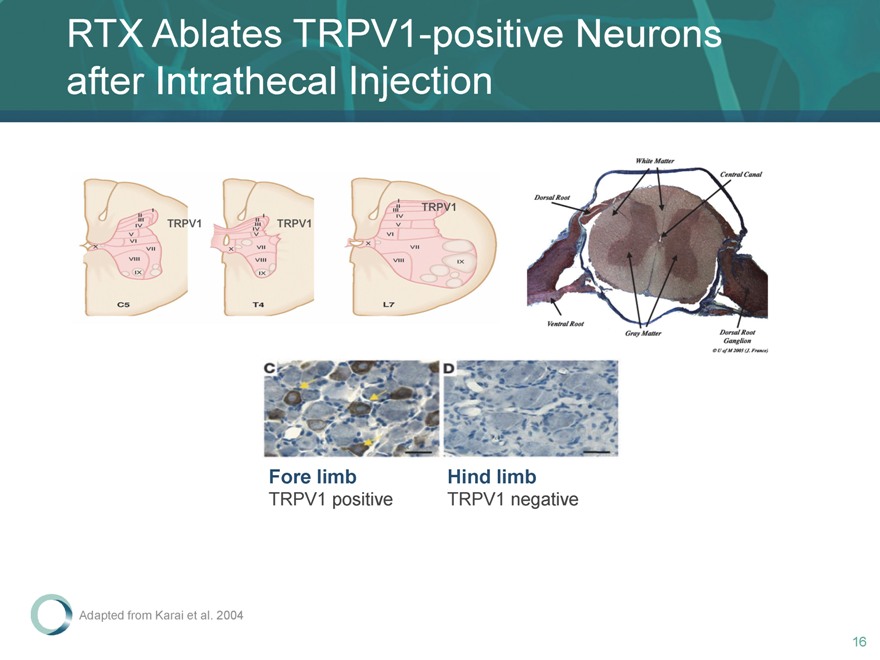
RTX Ablates TRPV1-positive Neurons after Intrathecal Injection
TRPV1 TRPV1 TRPV1
Fore limb Hind limb
TRPV1 positive TRPV1 negative
Adapted from Karai et al. 2004
16
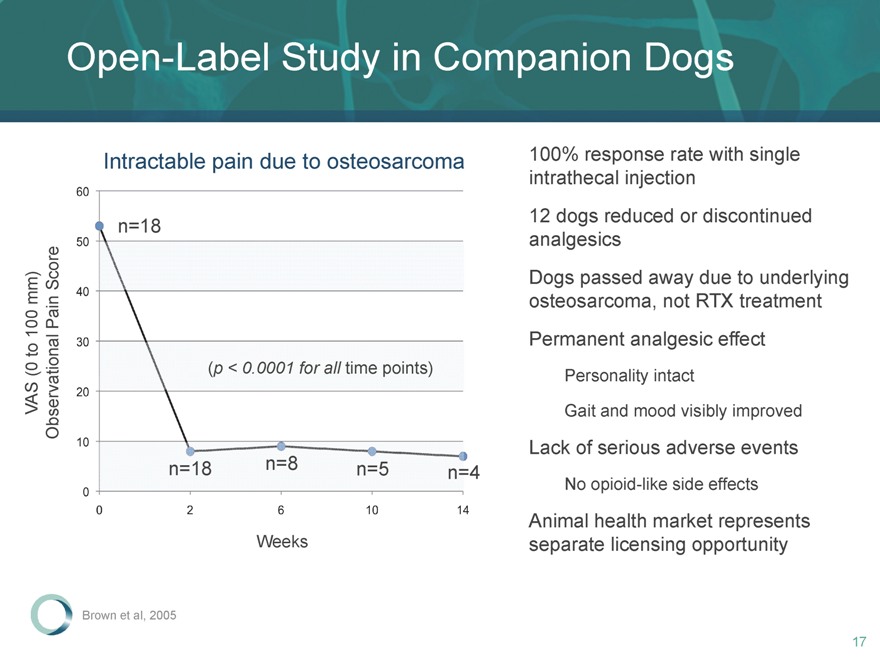
Open-Label Study in Companion Dogs
Intractable pain due to osteosarcoma 100% response rate with single intrathecal injection 12 dogs reduced or discontinued n=18 analgesics Score Dogs passed away due to underlying
mm)
Pain osteosarcoma, not RTX treatment
100
to Permanent analgesic effect
(0 (p < 0.0001 for all time points)
VAS Personality intact
Observational Gait and mood visibly improved
Lack of serious adverse events n=18 n=8 n=5 n=4
No opioid-like side effects
Animal health market represents Weeks separate licensing opportunity
Brown et al, 2005
60 50 40 30 20 10 0 0 2 6 10 14 Weeks
17
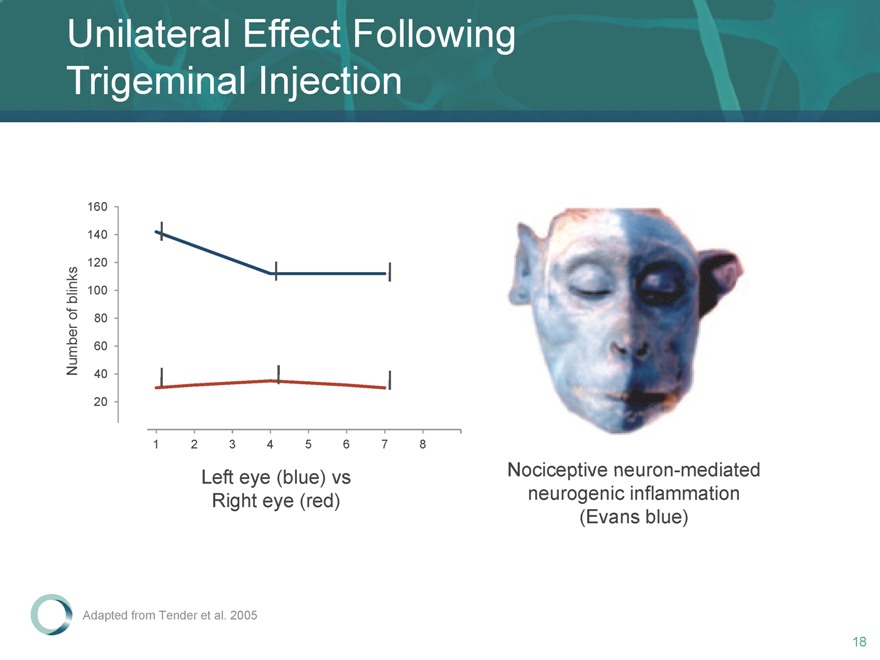
Unilateral Effect Following Trigeminal Injection
160
140
120 blinks 100 of 80
Number 60 40
20
12 345 678
Left eye (blue) vs Nociceptive neuron-mediated Right eye (red) neurogenic inflammation (Evans blue)
Adapted from Tender et al. 2005
18
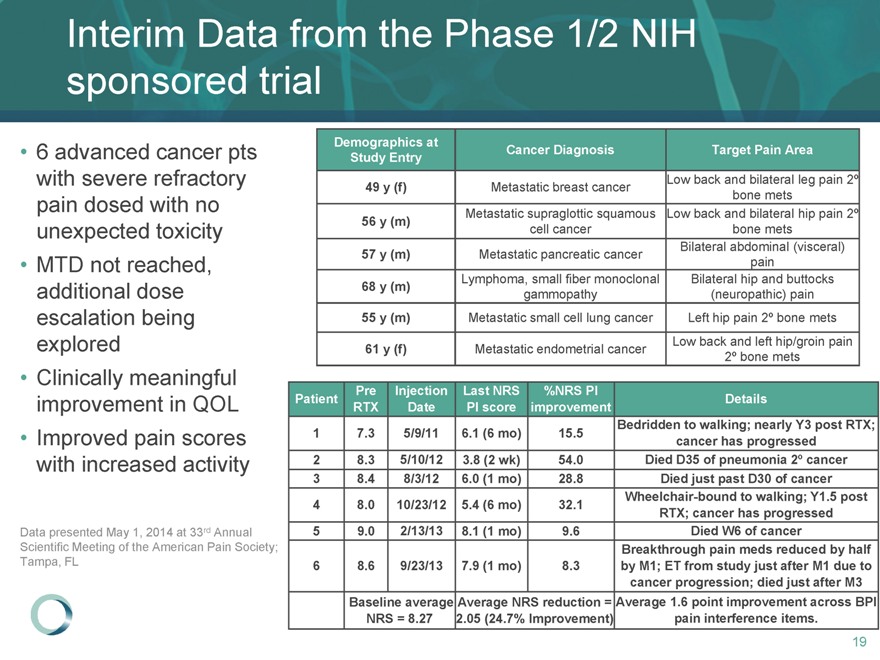
Interim Data from the Phase 1/2 NIH sponsored trial
• | | 6 advanced cancer pts with severe refractory pain dosed with no unexpected toxicity |
• | | MTD not reached, additional dose escalation being explored |
• | | Clinically meaningful improvement in QOL |
• | | Improved pain scores with increased activity |
Data presented May 1, 2014 at 33rd Annual Scientific Meeting of the American Pain Society; Tampa, FL
Demographics at Cancer Diagnosis Target Pain Area
Study Entry
Low back and bilateral leg pain 2º
49 y (f) Metastatic breast cancer bone mets
Metastatic supraglottic squamous Low back and bilateral hip pain 2º
56 y (m) cell cancer bone mets
57 y (m) Metastatic pancreatic cancer Bilateral abdominal (visceral)
pain
Lymphoma, small fiber monoclonal Bilateral hip and buttocks
68 y (m) gammopathy (neuropathic) pain
55 y (m) Metastatic small cell lung cancer Left hip pain 2º bone mets
Low back and left hip/groin pain
61 y (f) Metastatic endometrial cancer 2º bone mets
Patient Details
RTX Date PI score improvement
Bedridden to walking; nearly Y3 post RTX;
1 7.3 5/9/11 6.1 (6 mo) 15.5 cancer has progressed
2 8.3 5/10/12 3.8 (2 wk) 54.0 Died D35 of pneumonia 2º cancer
38.4 8/3/12 6.0 (1 mo) 28.8 Died just past D30 of cancer
Wheelchair-bound to walking; Y1.5 post
4 8.0 10/23/12 5.4 (6 mo) 32.1 RTX; cancer has progressed
5 9.0 2/13/13 8.1 (1 mo) 9.6 Died W6 of cancer
Breakthrough pain meds reduced by half
6 8.6 9/23/13 7.9 (1 mo) 8.3 by M1; ET from study just after M1 due to
cancer progression; died just after M3
Baseline average Average NRS reduction = Average 1.6 point improvement across BPI
NRS = 8.27 2.05 (24.7% Improvement) pain interference items.
19
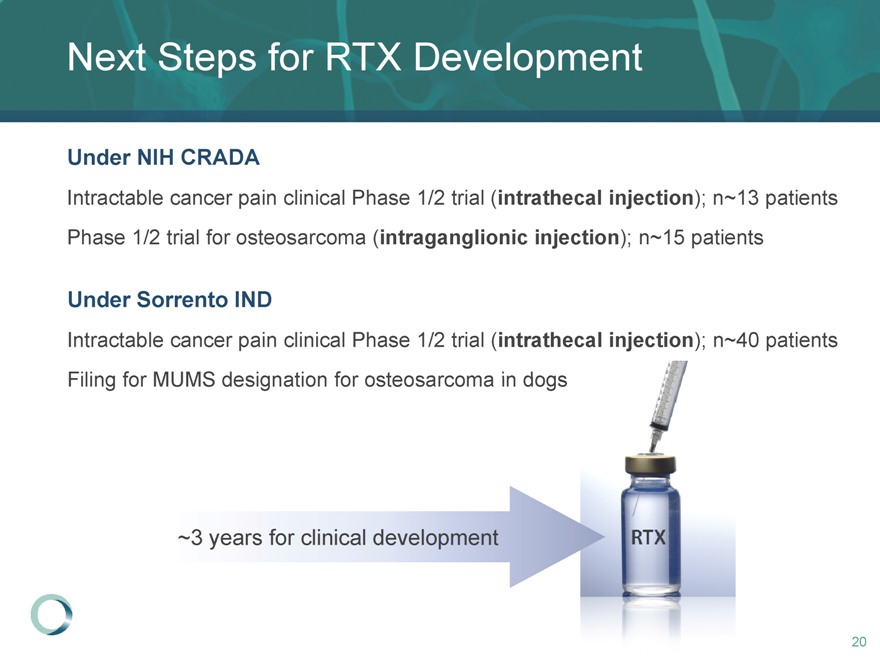
Next Steps for RTX Development
Under NIH CRADA
Intractable cancer pain clinical Phase 1/2 trial (intrathecal injection); n~13 patients Phase 1/2 trial for osteosarcoma (intraganglionic injection); n~15 patients
Under Sorrento IND
Intractable cancer pain clinical Phase 1/2 trial (intrathecal injection); n~40 patients Filing for MUMS designation for osteosarcoma in dogs
~3 years for clinical development
20
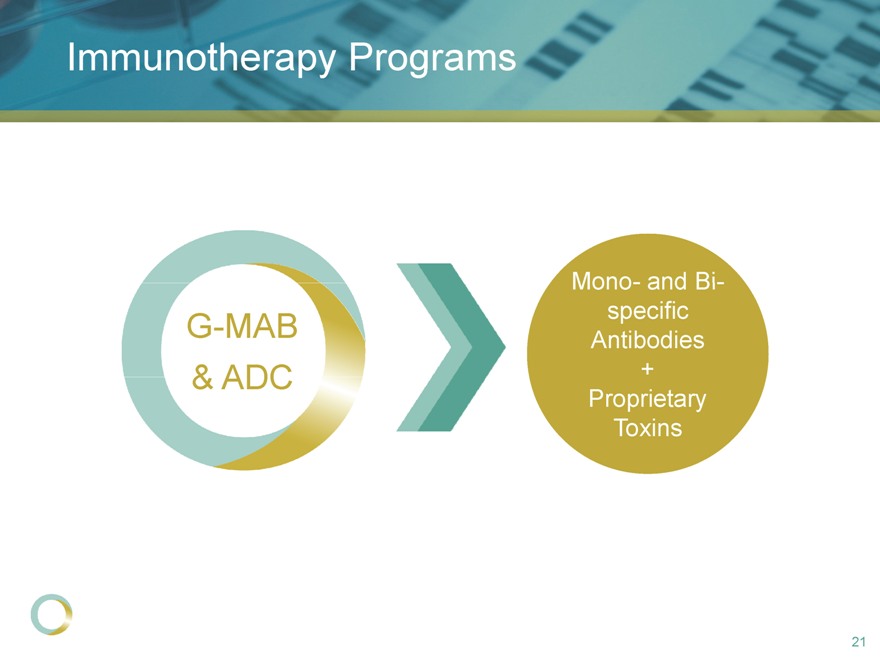
Immunotherapy Programs
Mono- and BiG-MAB specific Antibodies
&ADC +
Proprietary Toxins
21
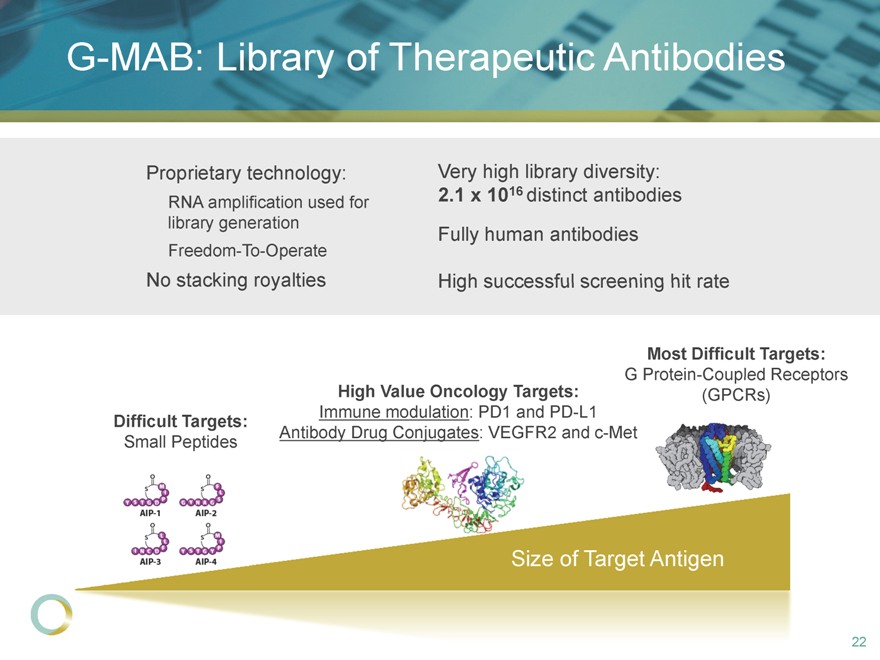
G-MAB: Library of Therapeutic Antibodies
Proprietary technology: Very high library diversity: 2.1 x 1016 distinct antibodies
RNA amplification used for library generation
Freedom-To-Operate Fully human antibodies
No stacking royalties High successful screening hit rate
Most Difficult Targets:
G Protein-Coupled Receptors
High Value Oncology Targets: (GPCRs) Immune modulation: PD1 and PD-L1
Difficult Targets:
Antibody Drug Conjugates: VEGFR2 and c-Met Small Peptides
Size of Target Antigen
22
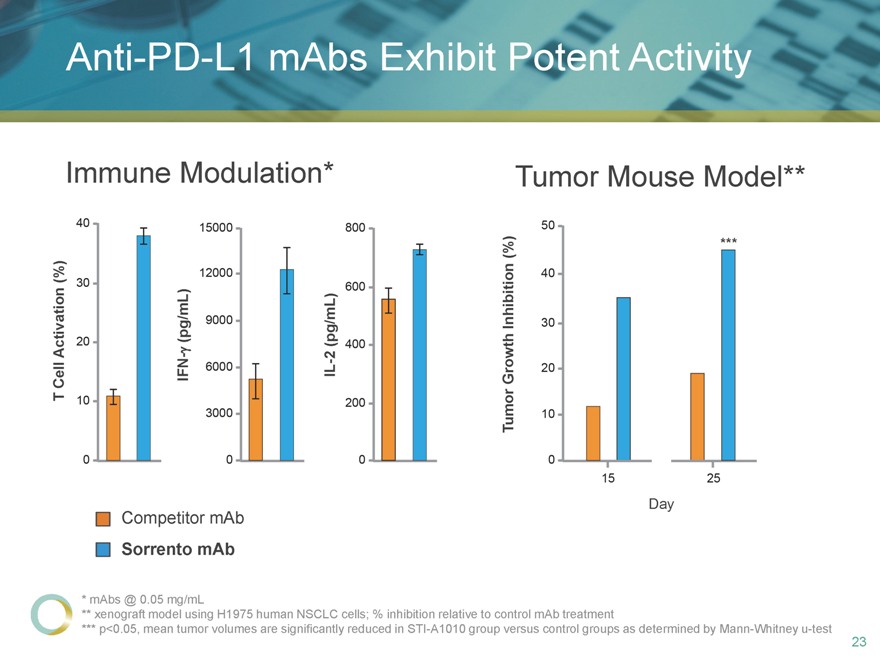
Anti-PD-L1 mAbs Exhibit Potent Activity
Immune Modulation* Tumor Mouse Model**
(%) *** (%) Inhibiti on (pg/mL) (pg/mL) Activation
—
IFN IL-Growth Cell T Tumor
Day
Competitor mAb
Sorrento mAb
** xenograft model using H1975 human NSCLC cells; % inhibition relative to control mAb treatment
*** p<0.05, mean tumor volumes are significantly reduced in STI-A1010 group versus control groups as determined by Mann-Whitney u-test
23
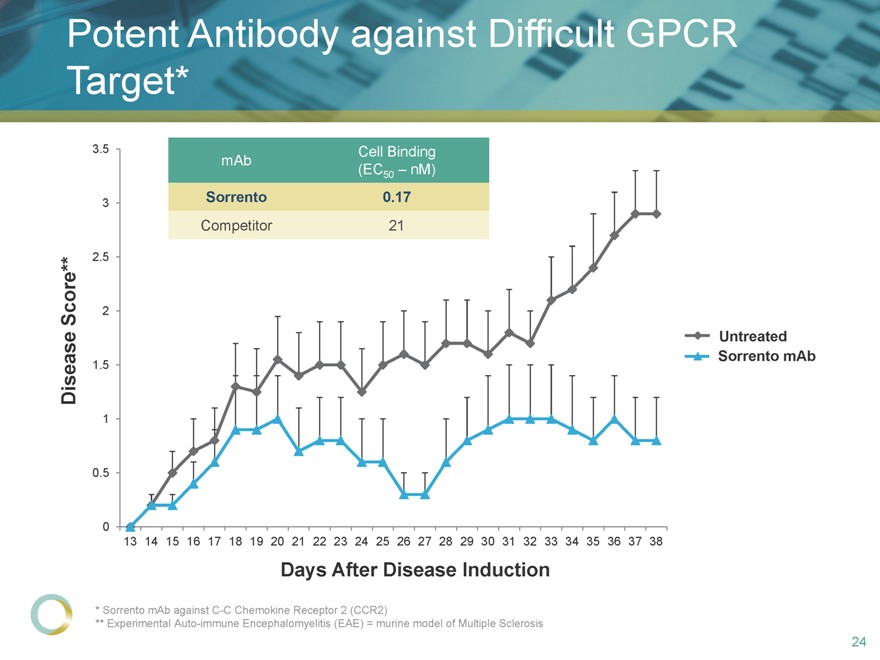
Potent Antibody against Difficult GPCR Target*
3.5 Cell Binding mAb (EC50 – nM)
Competitor 21
2.5
e** Scor 2
Untreated Sorrento mAb
Disease 1.5
0.5
0
13 14 15 16 17 18 19 20 21 22 23 24 25 26 27 28 29 30 31 32 33 34 35 36 37 38
Days After Disease Induction
* | | Sorrento mAb against C-C Chemokine Receptor 2 (CCR2) |
** Experimental Auto-immune Encephalomyelitis (EAE) = murine model of Multiple Sclerosis
24
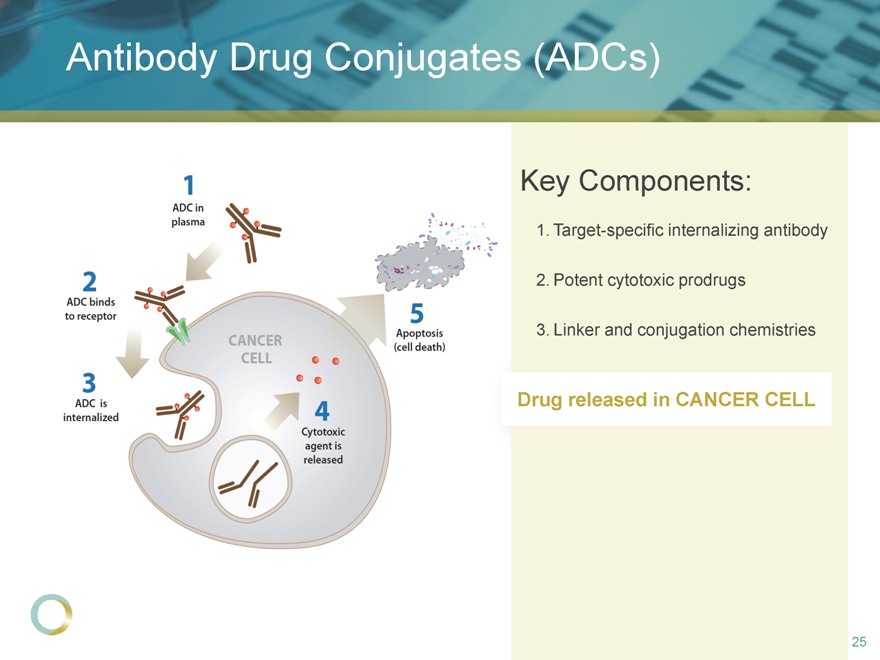
Antibody Drug Conjugates (ADCs)
Key Components:
1. Target-specific internalizing antibody
2. Potent cytotoxic prodrugs
3. Linker and conjugation chemistries
Drug released in CANCER CELL
25
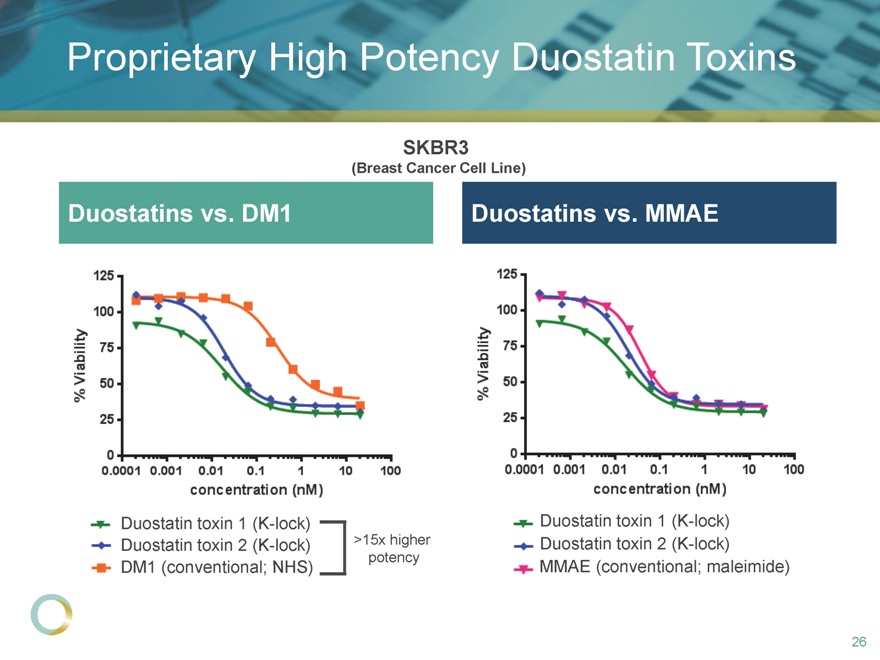
Proprietary High Potency Duostatin Toxins
SKBR3
(Breast Cancer Cell Line)
Duostatins vs. DM1 Duostatins vs. MMAE
Duostatin toxin 1 (K-lock) Duostatin toxin 1 (K-lock) Duostatin toxin 2 (K-lock) >15x higher Duostatin toxin 2 (K-lock) potency
DM1 (conventional; NHS) MMAE (conventional; maleimide)
26
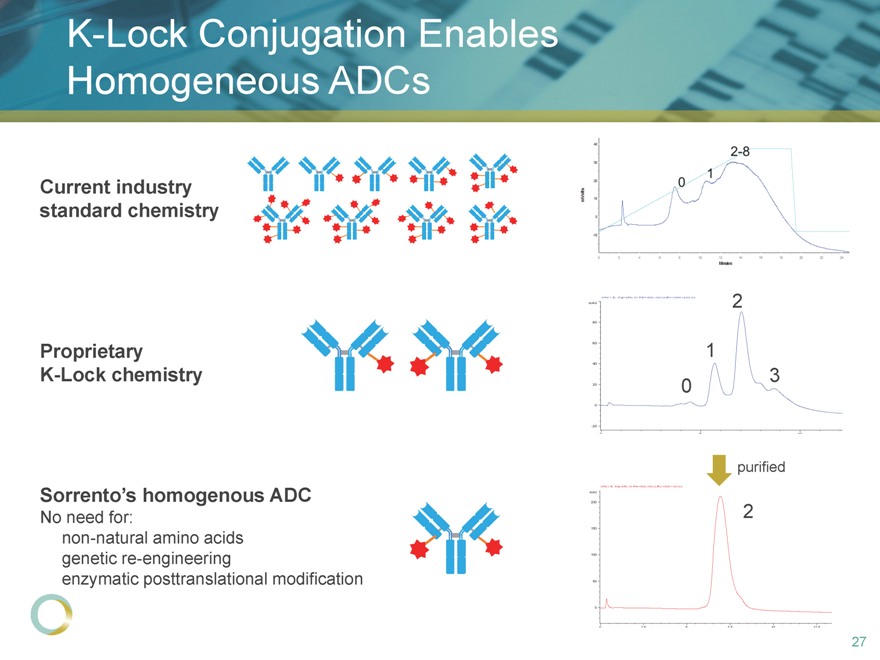
K-Lock Conjugation Enables Homogeneous ADCs
Current industry standard chemistry
Proprietary 1 K-Lock chemistry 3 0
purified
Sorrento’s homogenous ADC
No need for: 2 non-natural amino acids genetic re-engineering enzymatic posttranslational modification
0 1 2-8
27
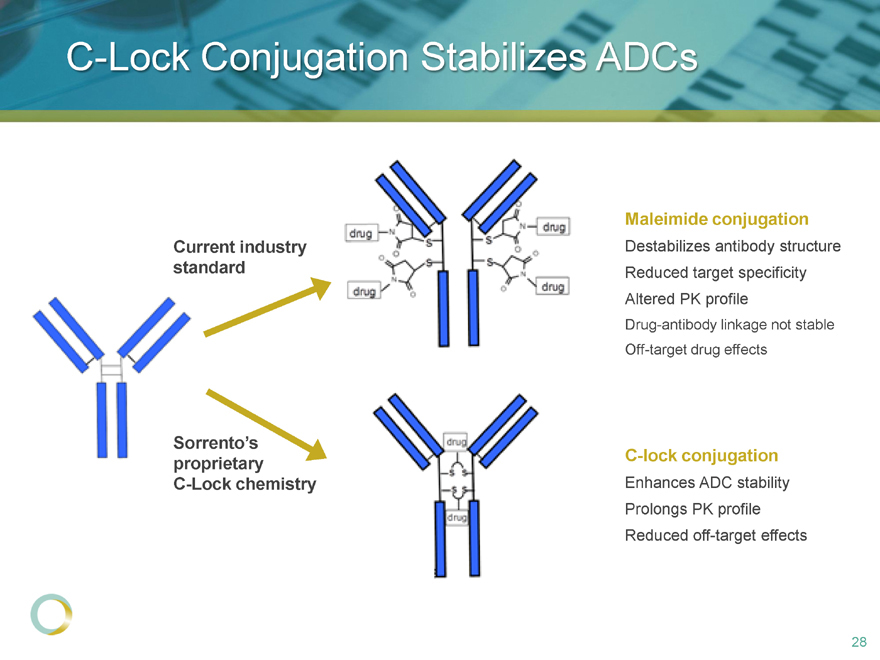
C-Lock Conjugation Stabilizes ADCs
Current industry standard
Maleimide conjugation
Destabilizes antibody structure Reduced target specificity Altered PK profile
Drug-antibody linkage not stable Off-target drug effects
Sorrento’s proprietary C-Lock chemistry
C-lock conjugation
Enhances ADC stability Prolongs PK profile Reduced off-target effects
28
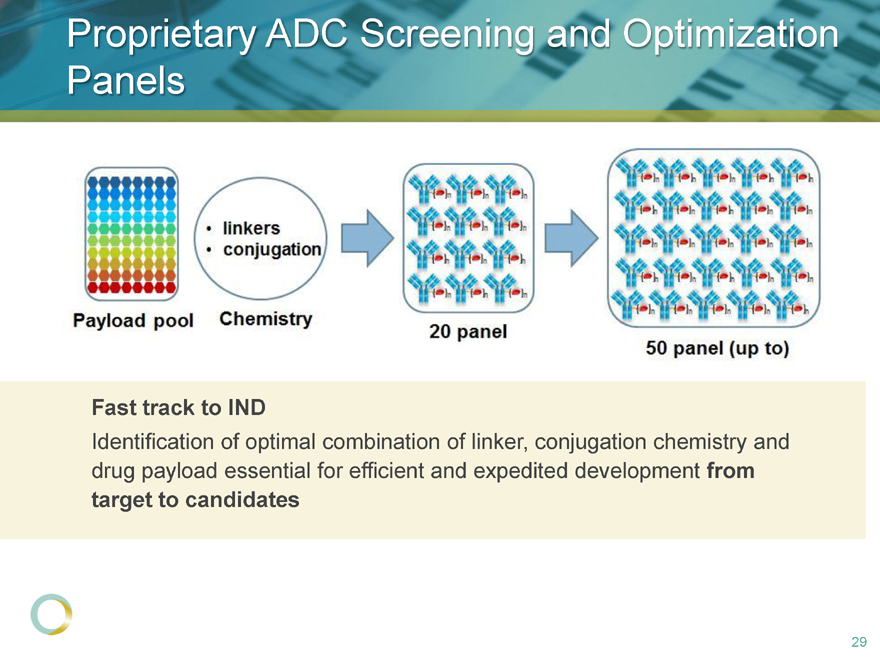
Proprietary ADC Screening and Optimization Panels
Payload pool linkers conjugation 20 panel 50 panel (up to)
Fast track to IND
Identification of optimal combination of linker, conjugation chemistry and drug payload essential for efficient and expedited development from target to candidates
29
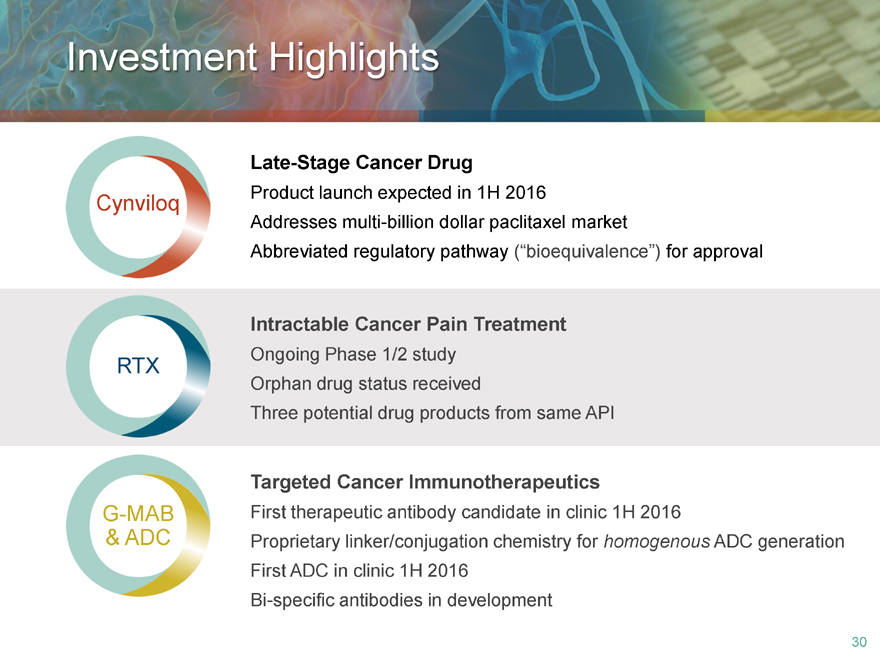
Investment Highlights
Cynviloq
RTX
G-MAB & ADC
Late-Stage Cancer Drug
Product launch expected in 1H 2016
Addresses multi-billion dollar paclitaxel market
Abbreviated regulatory pathway (“bioequivalence”) for approval
Intractable Cancer Pain Treatment
Ongoing Phase 1/2 study Orphan drug status received
Three potential drug products from same API
Targeted Cancer Immunotherapeutics
First therapeutic antibody candidate in clinic 1H 2016
Proprietary linker/conjugation chemistry for homogenous ADC generation
First ADC in clinic 1H 2016
Bi-specific antibodies in development
30
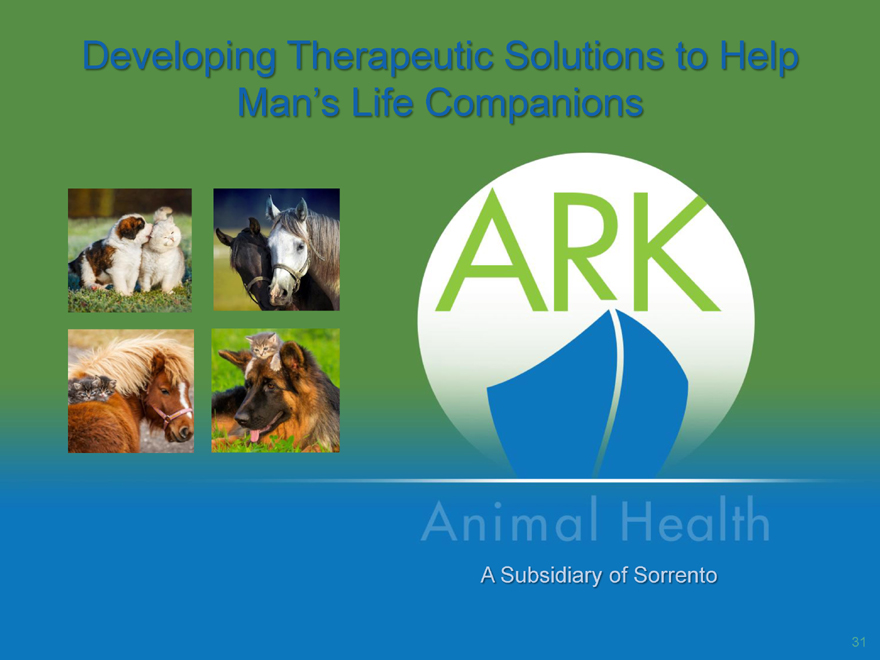
Developing Therapeutic Solutions to Help
Man’s Life Companions
ARK
Animal Health
A Subsidiary of Sorrento
31
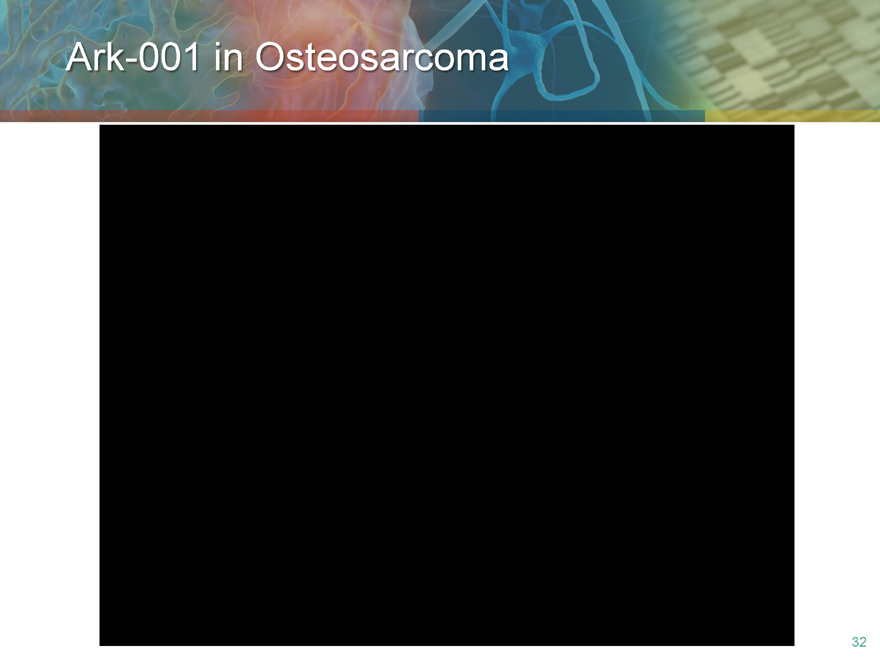
Ark-001 in Osteosarcoma
32
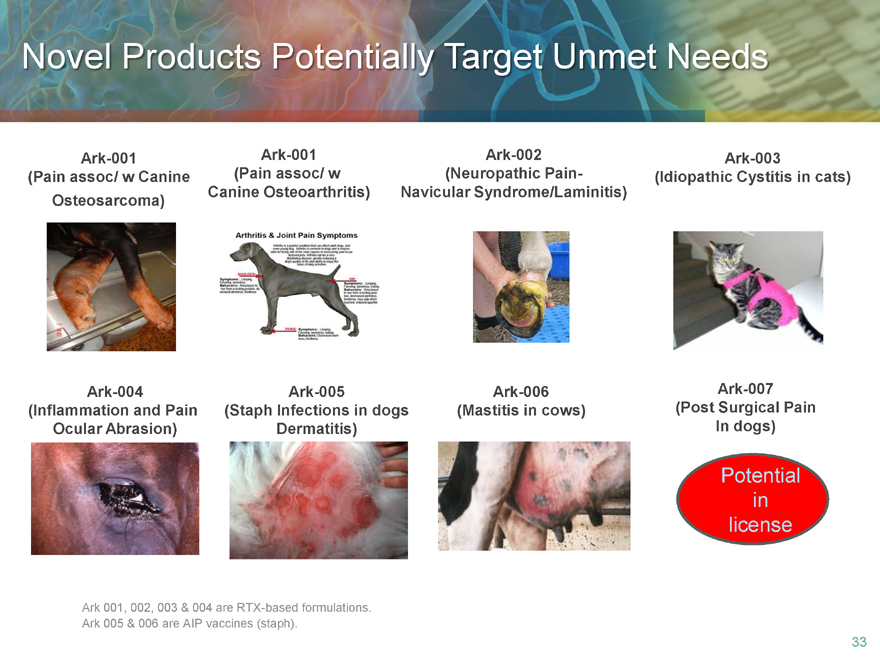
Novel Products Potentially Target Unmet Needs
Ark-001
(Pain assoc/ w Canine Osteosarcoma)
Ark-001
(Pain assoc/ w
Canine Osteoarthritis)
Ark-002
(Neuropathic Pain-
Navicular Syndrome/Laminitis)
Ark-003
(Idiopathic Cystitis in cats)
Ark-004
(Inflammation and Pain Ocular Abrasion)
Ark-005
(Staph Infections in dogs Dermatitis)
Ark-006 (Mastitis in cows)
Ark-007 (Post Surgical Pain In dogs)
Potential in license
Ark 001, 002, 003 & 004 are RTX-based formulations. Ark 005 & 006 are AIP vaccines (staph).
33
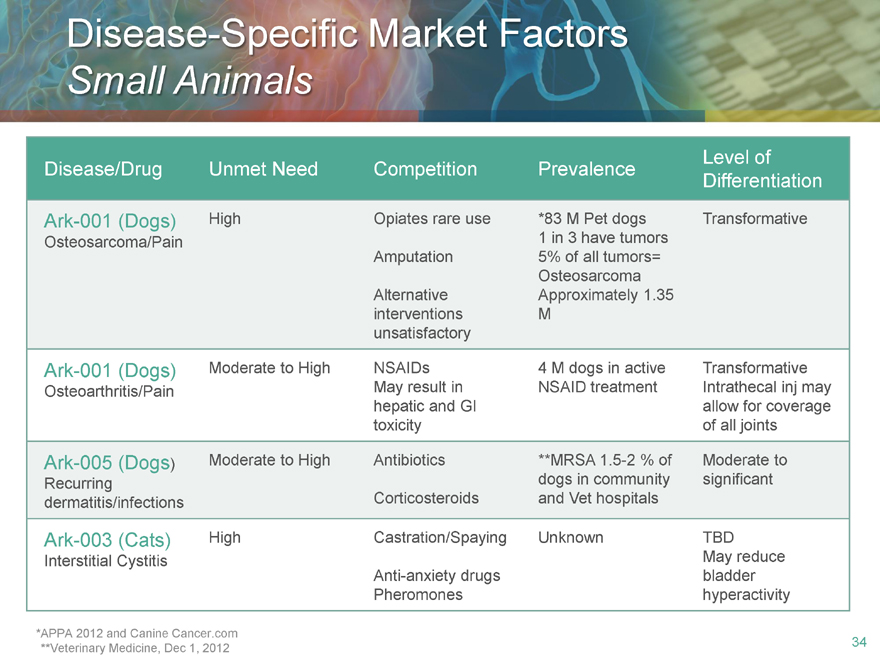
Disease-Specific Market Factors
Small Animals
Disease/Drug
Ark-001 (Dogs)
Osteosarcoma/Pain
Ark-001 (Dogs)
Osteoarthritis/Pain
Ark-005 (Dogs)
Recurring dermatitis/infections
Ark-003 (Cats)
Interstitial Cystitis
Unmet Need
High
Moderate to High Moderate to High High
Competition
Opiates rare use
Amputation
Alternative interventions unsatisfactory
NSAIDs May result in hepatic and GI toxicity
Antibiotics Corticosteroids Castration/Spaying
Anti-anxiety drugs Pheromones
Prevalence
*83 M Pet dogs 1 in 3 have tumors 5% of all tumors= Osteosarcoma Approximately 1.35 M
4 M dogs in active NSAID treatment
**MRSA 1.5-2 % of dogs in community and Vet hospitals
Unknown
Level of Differentiation
Transformative
Transformative Intrathecal inj may allow for coverage of all joints
Moderate to significant
TBD
May reduce bladder hyperactivity
*APPA 2012 and Canine Cancer.com
34
**Veterinary Medicine, Dec 1, 2012
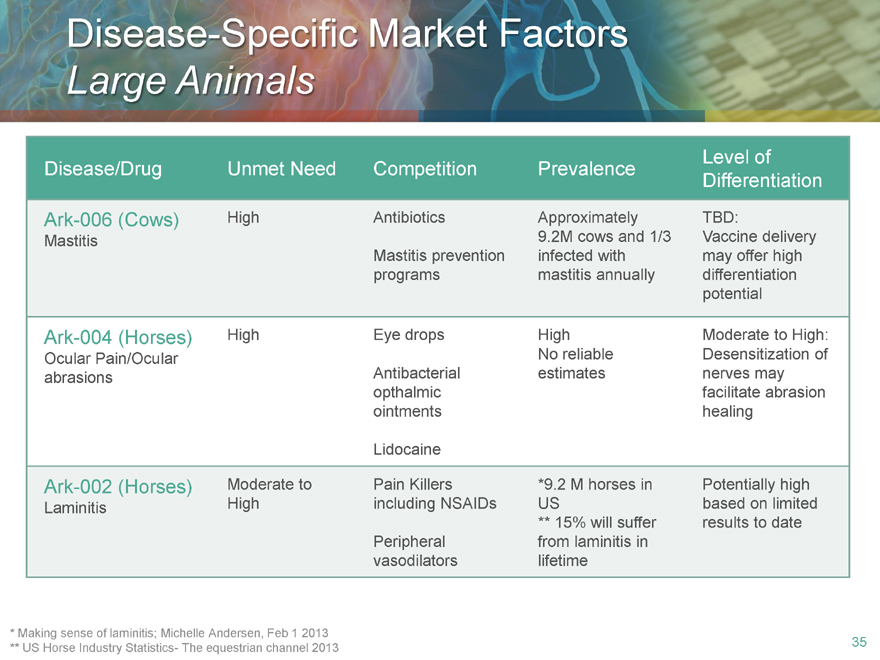
Disease-Specific Market Factors
Large Animals
Disease/Drug
Ark-006 (Cows)
Mastitis
Ark-004 (Horses)
Ocular Pain/Ocular abrasions
Ark-002 (Horses)
Laminitis
Unmet Need
High
High
Moderate to High
Competition
Antibiotics
Mastitis prevention programs
Eye drops
Antibacterial opthalmic ointments
Lidocaine
Pain Killers including NSAIDs
Peripheral vasodilators
Prevalence
Approximately 9.2M cows and 1/3 infected with mastitis annually
High No reliable estimates
*9.2 M horses in US
** 15% will suffer from laminitis in lifetime
Level of Differentiation
TBD:
Vaccine delivery may offer high differentiation potential
Moderate to High: Desensitization of nerves may facilitate abrasion healing
Potentially high based on limited results to date
* Making sense of laminitis; Michelle Andersen, Feb 1 2013
35
** US Horse Industry Statistics- The equestrian channel 2013
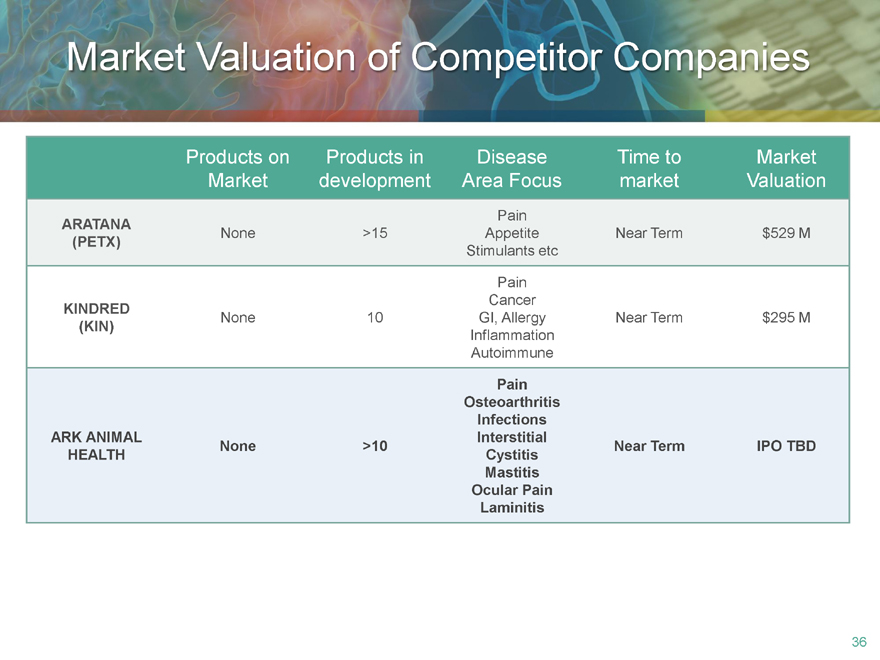
Market Valuation of Competitor Companies
ARATANA (PETX)
KINDRED (KIN)
ARK ANIMAL HEALTH
Products on Market
None
None
None
Products in development
>15
10
>10
Disease Area Focus
Pain Appetite Stimulants etc
Pain Cancer GI, Allergy Inflammation Autoimmune
Pain Osteoarthritis Infections Interstitial Cystitis Mastitis Ocular Pain Laminitis
Time to market
Near Term
Near Term
Near Term
Market Valuation
$529 M
$295 M
IPO TBD
36
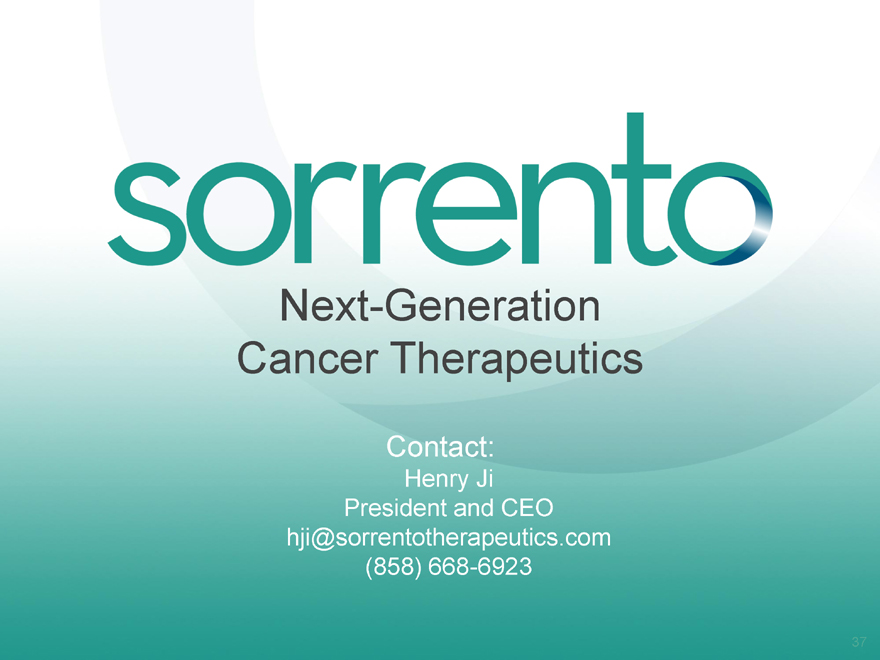
sorrento
Next-Generation
Cancer Therapeutics
Contact:
Henry Ji President and CEO hji@sorrentotherapeutics.com (858) 668-6923




































